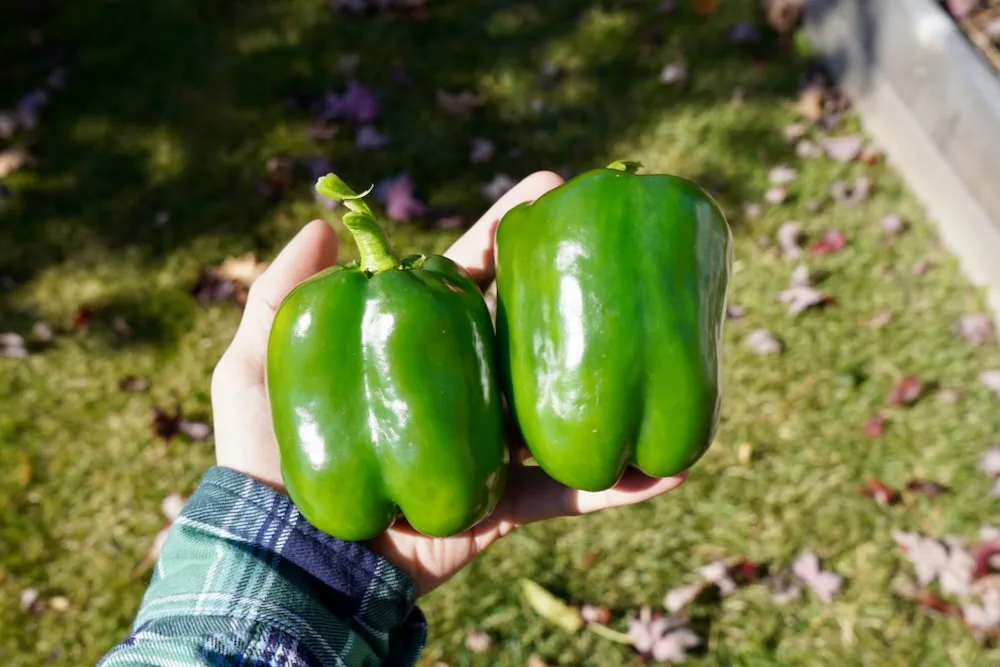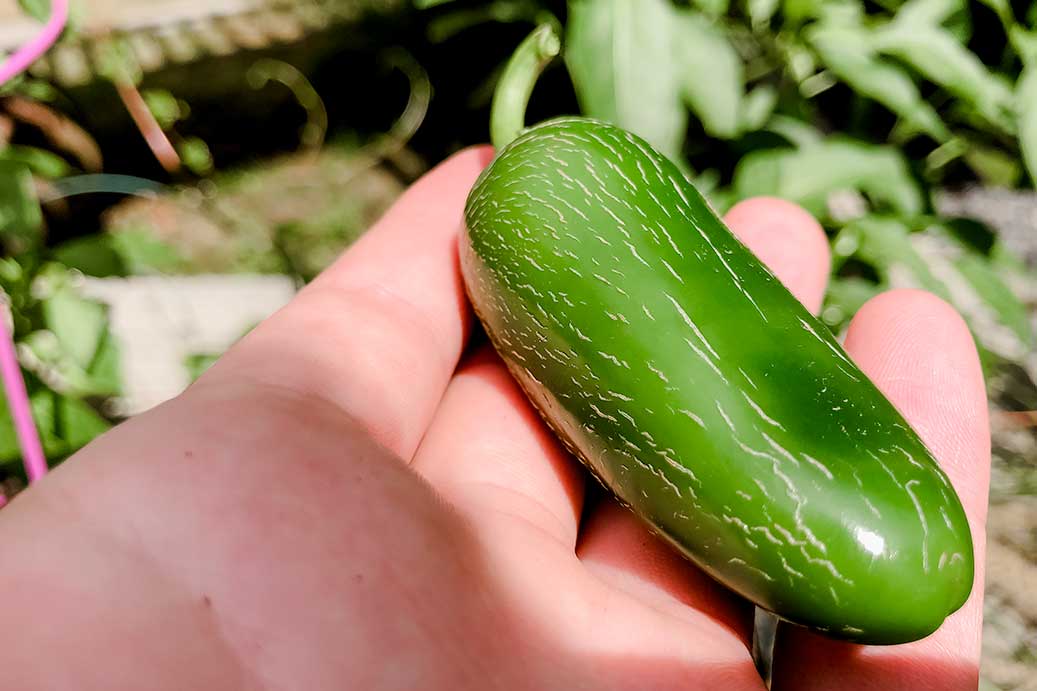Peppers come in all sorts of shapes and sizes. It can be difficult to determine exactly when they’re ready to be plucked. How can you tell when peppers are ripe and ready to pick? Here, I’ll share exactly when to pick peppers of any type in your garden.
As a gardener, knowing when to harvest your vegetables is key to getting the best flavor and maximizing your crop yield. This is especially true when it comes to peppers. With their long growing season and gradual ripening process, it can be tricky to figure out the perfect time to pick them But have no fear! In this comprehensive guide, we’ll walk through all the signs to look for so you can confidently determine when your peppers are ready for picking
The Long Wait – Understanding The Peppers Ripening Timeline
Peppers take time. A lot of time. Most varieties will mature and be ready for harvest 60-150 days after being transplanted outside. This makes them one of the longest crops in the garden!
It’s important to be patient and resist picking your peppers too early Unlike tomatoes, peppers don’t continue to ripen efficiently off the plant For best flavor and nutrition, you’ll want to leave them on until fully mature.
Bell peppers and sweet varieties take on average 75-90 days to mature Hot peppers like jalapenos can be ready in 60-80 days. And extra spicy peppers like habaneros will need 90-120 days of growth before reaching maturity
Within that long window, individual peppers on the same plant will be ready at different times. So check your plants frequently as you get closer to the “days to maturity” time frame.
1. Examine The Pepper’s Size And Shape
One of the best indicators a pepper is ready for harvest is if it has reached its expected mature size and shape.
Pepper seed packs will list the typical size. Or you can look up what dimensions are standard for that variety.
For example, bell peppers are usually 3-4 inches wide when ripe. Banana peppers grow 4-6 inches long. And jalapenos should be about 2-3 inches long.
The shape of the pepper is also telling. When immature, peppers are often lopsided or curved. As they ripen, they fill out to have straight sides and smooth shoulders.
Mature peppers feel heavy for their size and have a smooth, glossy appearance.
2. Inspect The Pepper’s Color
Most peppers start off green and turn color as they ripen. Waiting for full color change is a fool-proof way to know your pepper is fully mature.
Sweet peppers will transform to red, orange, yellow, or even purple when ready. Hot varieties like jalapenos turn bright red. Habaneros change from green to orange or red.
Even green varieties like bell peppers will darken to a deep, rich shade when ripe and ready to eat.
Once a pepper has reached full size, complete color change takes 2-4 weeks. Time your harvest planning around when you first notice color starting to show.
3. Check For Signs Of Ripening
As peppers near maturity, their skins transform in telling ways. Here are two signs a pepper is almost ready:
Wrinkled, loose skin – As the flesh inside plumps up, the skin will wrinkle and detach slightly from the inner membrane. Gently press a pepper with your thumb. If indentations remain for a few seconds, harvest time is near.
Stretch marks – Vertical streaks running down the sides of a pepper, called “corking”, happen when the flesh grows faster than the skin can keep up. Hot varieties like jalapenos display the most prominent marks. But any pepper with pronounced divots is ripe for picking.
4. Monitor For Damage
Be on the lookout for insect infestations, sunscald damage, or other disease issues. Pick affected peppers right away, even if they aren’t fully mature.
The undamaged portion is still usable. And removing compromised fruit allows the plant to focus energy on ripening healthy peppers.
When Can Peppers Be Picked Early?
While ideal flavor comes from vine ripening, you don’t have to wait for full maturity to start enjoying your peppers.
In fact, harvesting a portion of fruits while still green has several advantages:
-
Satisfies impatience to taste the harvest
-
Encourages further production – picking relieves the plant so it keeps flowering and fruiting
-
Allows you to stagger ripening times
As soon as peppers reach mature size, grab a few to use green. Then leave the rest to continue changing color. Mixing up maturity levels results in a longer harvest window.
Just know green peppers will be less sweet, less flavorful, and less spicy than vine-ripened ones.
Preparing For Your First Frost
Cold weather brings a definitive deadline for pepper harvesting. If frost is approaching, prioritize clearing as many mature peppers as possible, even if they aren’t perfectly ripe.
Here are a few tips:
-
Prune back plants 2-3 weeks before expected frost date. Removing excess foliage helps direct energy into finishing off existing fruits.
-
Pick all peppers showing color, and bring indoors to finish ripening in a warm spot out of direct sun.
-
Harvest remaining large green fruits, and place in a paper bag with an apple or banana. The ethylene gas from the ripening fruit will continue maturing the green peppers.
-
Pull up entire pepper plants and replant in containers to grow as houseplants over winter. Peppers will continue ripening indoors.
How To Pick Peppers Without Damage
Proper technique is key to harvesting without harming your plants. Follow these steps:
-
Use pruners, scissors, or gardening shears to snip peppers off cleanly. Never yank or tug fruits off.
-
Leave a short stem attached to prevent moisture loss. Quickly use peppers with no stems.
-
Hold the pepper firmly at the base while cutting to avoid pulling on the branch.
-
Harvest in the morning after dew dries to avoid spreading disease.
-
Pick often to encourage production. The more you harvest, the more the plant will flower and fruit.
Storing Your Bountiful Harvest
A bumper pepper crop calls for proper storage savvy. Here are tips for enjoying peppers as long as possible after picking:
-
Store unwashed peppers in loose plastic bags in the crisper drawer for 2-3 weeks. Wash just before using.
-
Freeze extras by slicing raw peppers into pieces or puréeing into sauce.
-
Pickle peppers in vinegar brine. Will last for months refrigerated.
-
Dry peppers, whole or sliced, using a food dehydrator or oven. Store in airtight containers.
-
Turn surplus peppers into jams, salsas, seasonings, and other shelf-stable products.
Part of the fun of growing peppers is discovering the perfect time to harvest based on visual cues and feel. Maturity indicators will vary slightly depending on climate, soil conditions, and other factors. So get to know what ripeness looks like in your garden. With the satisfaction of a successful harvest, you may find those long months of patience pay off!

When Are Peppers Ripe?
Different pepper varieties ripen at different rates. Hot peppers are usually slower to ripen than sweet peppers. If you have a seed packet, check the back to get an idea of the average time-to-harvest.
The best way to tell when peppers are ready to pick is to look for changes in color. Almost all pepper varieties will go through a color change during the ripening process. For example, bell peppers change from green to a deep red when fully ripened.
Unripe and ripe bell peppers.
Peppers are edible at any stage of growth, but the flavor will be different. Unripe peppers will usually have less sweetness and more bitterness than ripe ones. If you want maximum heat, hot peppers are usually at their hottest when they are just turning color.
Under ideal conditions, most peppers will produce ripe peppers after 90-150+ days from transplanting. If you are growing any superhot varieties, like the ghost pepper or any habaneros, they will take longer. Bell peppers and jalapeños are typically ready for harvesting on the lower end of that scale.
Starting pepper seeds indoors is one way to get your peppers to produce earlier. This allows you to extend the season in early spring, giving the plants more time to mature outdoors in summer and fall. If you’re not sure if your peppers are ready to pick, count back the days to when you planted outside.
Timing is especially important to keep in mind as the growing season draws to a close. You don’t want to let your pepper plants stay out overnight if there is a potential frost. Be sure to harvest any final peppers before this happens!
Corking is a natural marking that can appear on many pepper varieties. It occurs when a pepper’s skin grows slower than the flesh, causing tiny stretch marks on the skin. White lines appear when the skin heals over the wounds.

Corking is completely normal and corked peppers are edible. It indicates that a pepper is maturing and may be ready for harvest.
When To Pick Peppers
Depending which peppers you’re growing, you may harvest at different times. To make it simple, I have put together when to pick the most common peppers. For all other peppers, just follow the basic principles of harvesting peppers:
- Changing color
- Peppers reach a mature size and stop growing
- Softening flesh (over-ripe)
- Easily picked from stem
- Corking (on some varieties)
Note: If you plan to save pepper seeds, wait for the peppers to fully mature and change color before harvesting. This ensures that the seeds are mature and will germinate when planted next year.
Harvesting Peppers – When To Pick Peppers (Jalapenos, Bell, Banana, Ghost & More)
FAQ
How to tell when a pepper is ripe?
Can you leave peppers on the vine too long?
If you leave the peppers on longer, the ripening process may continue and possibly lose or gain flavor (but the color should stay pretty much the same, and it’s still ripe when it first changes the final color). If you leave it on too long, some of the seeds may rot.
Can you leave bell peppers on the plant too long?
Occasionally, peppers can become damaged while still attached to the mother plant. I have had this happen from pest incursion, an accidental impact, and sometimes, it’s just a mystery. However, if you leave it on the plant, it will rot from the damage outward as time goes on, so use it or lose it!
